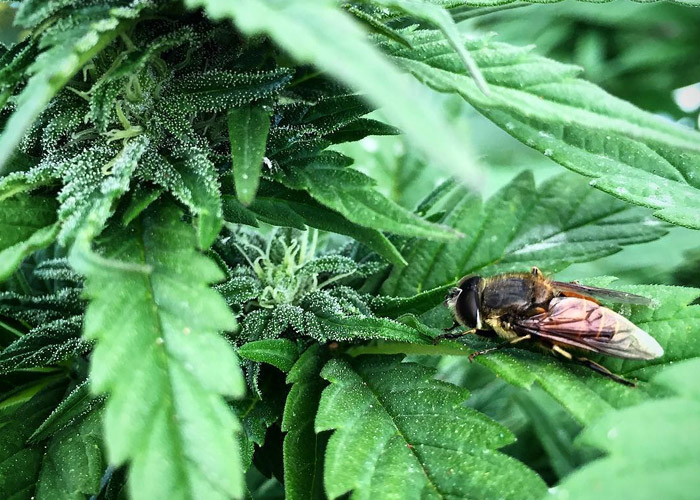By Santiago Acosta

Dr. Santiago Acosta is a veterinarian at the University of La Salle (Colombia) and a Communication and Environment specialist at the National University of La Plata (Argentina). Initially drawn to researching uses of the plant due to family health issues, Dr. Acosta has garnered more than 6 years of clinical and teaching experience in cannabinoid veterinary medicine. Thanks to cannabis becoming a regulated drug for medical purposes in Colombia, he has so far treated more than 150 patients with medicinal cannabis, most of them very successfully. Seeking to improve formal training in this area, Acosta created in 2019 the first certified course in veterinary cannabinoid medicine, designed in partnership with the School of Veterinary Medicine of the Universidad Nacional de Colombia. He later successfully replicated this in countries such as Chile, Argentina and Mexico. He is also a professor at two Specialization Programs offered by the Universidad del Rosario and the Universidad de Caldas. Acosta is currently the president of the Latin American Veterinary Cannabinoid Medicine Association (AMVC Latam), a group of veterinarians from 8 countries in the region who work to raise awareness on the proper use of cannabinoids in animal patients. He has been an international guest speaker at a number of academic events around medical cannabis, and is currently dedicated to the critical role of monitoring and assisting efforts for the creation of legislation regulating the use of cannabis-based medicine in Colombia, including by providing active contributions to the draft of the bill.
Discussions of the Endocannabinoid System (ECS) often neglect to consider the importance of this homeostasis mechanism from a neurobiological perspective. Its evolutionary history tells us that mammals – humans included – are not the only living organisms to harbor this complex survival mechanism. As such, this article will illustrate some key aspects of the development of the ECS in animals and how the field of Veterinary Cannabinoid Medicine can play a key role in clinical, educational and public health practices.

Evolutionary history of the animal ECS
The facts that the ECS is present in almost the entirety of the animal kingdom – not only in humans – and that its main role is to maintain balance in the organism give us a glimpse of its complex phylogenetic development. The ECS is so evolutionarily old that some authors propose its evolution occurred jointly with that of the nervous system itself in vertebrates, and this long path of transformations features a fundamental player we must get to know better: arachidonic acid.
This cell-membrane derivative, part of the Omega 6 complex, is the fundamental structure of all discovered endocannabinoids. It is considered the key piece in the evolution of this intercellular communication system, a journey that starts in the arachidonic acid system in plants and ends in Ciona intestinalis, a close relative of modern vertebrates and the first animal known to have a cannabinoid receptor (CBR).
The next leap was the emergence of all the structures that make up an ECS in vertebrates: cannabinoid receptors, endocannabinoids, and the enzymes that metabolize these neuromodulators. As it progressed, this evolutionary process left traces in some invertebrates: insects (ants), annelids and aquatic invertebrates (leeches, snails) have all shown signs of the presence of this system. Different laboratory tests using cannabimimetics in this these species have shown that some endocannabinoids appear when presented with an induced stimulus, such as appetite or pain. This could also be verified by a change in some behavior patterns, such as the search for food or learning processes, when using one of these synthetic cannabinoids.
In sum: both humans and most animals feature a specific intercellular communication network called the Endocannabinoid System (ECS), which allows them to efficiently regulate their vital functions in response to the demands of their environment. Modern studies of this complex system have paved the way for the concept of Veterinary Cannabinoid Medicine (VCM), i.e., the modulation of this communication network with substances that mimic the function of endocannabinoids like those present in the Cannabis Sativa L. plant.
Next, we are going on a journey through the history of phytocannabinoid use in non-human patients and the current state of affairs of this medical field.
Veterinary cannabinoid medicine: past, present and future
Background
Dr. Ethan Russo, the son of a family of veterinarians and one of the most influential medical cannabis research pharmacologists, reviewed the history of cannabis-based drug use in veterinary medicine for a presentation at the last seminar of the Latin America Association for Cannabinoid Veterinary Medicine (AMVC Latam). Here are a few highlights of his findings:
- Up until prohibition (1930-1940), cannabis was a fundamental part of the veterinary pharmacopoeia.
- In India, it was used to treat diarrhea in cattle and increase milk flow and appease cows, as well as to increase energy and stamina in oxen. It was also here where Sir William Brooke O'Shaughnessy, the father of cannabinoid medicine in the West, conducted his studies of the plant. Before using cannabis on his human patients, he administered it to stray dogs in order to demonstrate its low toxicological effect.
- The Chinese Empire made similar use of the plant, where it was applied to relieve digestive tract issues in animals and as an anticonvulsant.
19TH CENTURY
- Europe: in France, cannabis seed oil was used as a laxative in cattle and for some dermatological conditions in dogs. In Italy, cannabis sativa resin was used to treat stomach cramps in horses. In Scotland, cannabis' sizeable impact as an analgesic, antispasmodic and hypnotic drug in humans led to a rise in its popularity in veterinary medicine as well. In England, it was used by veterinarians to treat asthma, seizures, coughs, cystitis and tetanus.
- In South Africa, it was used for intestinal inflammation and cough in equines and for epilepsy treatment in dogs.
- In the United States, Cornell University, in addition to investigating its use in cystitis and tetanus, demonstrates the efficacy of cannabis in the excitatory phase of azotemia and overexertion rhabdomyolysis in equines. The University of Pennsylvania conducted an extensive study of the analgesic, antispasmodic and hypnotic properties of cannabis. Finally, Harvard University researchers observed a connection between cannabis and the high survival rate of patients infected with tetanus.
The development of veterinary cannabinoid medicine
Thanks to a new era of research and clinical use of cannabis initiated in the 1960s, veterinary medicine has found a number of plant compounds that provide effective and safe therapeutic tools, just like in human medicine. However, the prohibitionist era meant the first serious cannabis studies were chiefly concerned with cannabis intoxication events suffered by different animals. Parallel to this, Dr. Rafael Mechoulam and his research team were already working on the functional description of the ECS, a task that was completed at the start of the new millennium (1999-2000).
Once a complete description of this wonderful intercellular communication network was available, researchers were finally able to investigate crucial processes, such as the plant's effect on organisms (pharmacokinetics), and the effect of organisms on the plant (pharmacodynamics), and many more. By this time, we see the emergence of a full-fledged academic and scientific environment for the study of cannabis and its medical use, and some veterinarians begin investigating how these compounds affect the domestic and wild animal pathologies they treat. What they quickly realize is that their uses do not vary by much: cannabinoids have mostly the same analgesic, anti-inflammatory, antiepileptic, neuroprotective and immunomodulatory properties in other animals that they show in humans.
As the results of the first animal studies came in, scientists gradually realize that the vertebrates' varied physiologies share a common place where medical interventions based on cannabis derivatives were the most effective: the ECS. As we better understood this close neurobiological relationship, we could see how preclinical trial models in human research translated into models for animal trials. Likewise, the developments of clinical models in veterinary medicine can serve as preclinical models for human medicine. Hence the importance of starting to see medical cannabis from the perspective of translational medicine, that is, focusing on how to effectively bring research to clinical practice by taking advantage of all stakeholders in this chain.

Present
Cannabinoid veterinary medicine has developed at a break-neck pace over the last ten years. There is now a robust foundation of information on VCM, allowing us to approach cannabis use in veterinary patients in a much more formal way. One example is the study of the most marked differences between the human and canine ECS, which is the most common veterinary clinical model.
Miller conducted a complete study in 2018 of the location and quantification of cannabinoid receptors in dogs, concluding that distribution is similar to that of humans, but the expression of type-1 cannabinoid receptors (CB1) is higher in canines. This is the primary reason why dogs are more sensitive to cannabis, as CB1 receptors are abundant in the central nervous system. The second reason is that when THC (a psychoactive plant compound with high affinity for CB1s) passes through their liver, it results in two active metabolites, compared to one in humans. This does not mean THC cannot be used as a pharmacological tool for dogs; in fact, it is used, with great success, provided that care is provided by a professional and the drugs used are safely administered for the conditions in which they are the most effective: pain, inflammation, neuroprotection.
There has been an increase in cannabis use in veterinary clinics in Europe and America, largely a result of the changes seen in recent years of the regulatory status of the plant for different contexts. That said, there are two key concepts that must be taken into account from an ethical and scientific perspective as cannabis use transitions from media fad to a health promotion industry: drug development practices that respect the pharmacological standards of each context, and the cannabinoid medicine education veterinarians receive.
On the one hand, there are still many gaps in the regulation for informed and safe access to veterinary drugs. Some countries still prohibit the medicinal use of cannabis. In many countries that have already legalized medicinal cannabis use, veterinarians are not explicitly included, widening the gap of ignorance that already exists in the profession. In other countries, even when veterinarians are allowed to prescribe cannabis, it is not easy to obtain drugs that meet the standards for veterinary medicine, and drugs for human use are prohibitively expensive. What we see, then, is a great opportunity for investment and research groups seeking to explore a market niche that is often neglected but, in practice, is actually a high-demand one, thanks to the implicit advertising for medicinal cannabis.
On the other hand, there is a great shortage of formal research regarding the ECS and the use of phytocannabinoids as a therapeutic option. We must start demanding more studies of topics related to this system and its modulation with the different derivatives of the plant, not only in veterinary medicine, but also in human medicine as well. As things stand today, not all contents offered cover the needs of veterinarians wishing to discuss cannabis derivatives as options with their patients. That said, there are some reference initiatives focused on developing and publishing specific educational content for this area: Examples include content developed by the Canadian Association of Veterinary Cannabinoid Medicine (CAVCM), Veterinary Cannabis in the United States, this very Latin America Association of Cannabinoid Veterinary Medicine (AMVC Latam), and EndoVet, which created the first certified cannabinoid veterinary medicine course offered by a School of Veterinary Medicine, namely at the National University of Colombia.
The future
The stark similarities between the animal and human ECSs are evident. Also evident is the fact that cannabis plant derivatives can play a fundamental role in animal health. It is time, then, to formalize the legal and educational processes that will allow pet owners to make the best possible decision so they can provide a more caring treatment to the animal. Medical cannabis is changing ways of doing medicine, helping therapists become increasingly more adept at practicing individualized medicine and offering new therapies to patients that are both effective and devoid of severe adverse effects.
The moment has come to formally introduce endocannabinology concepts into the study curricula of all human- and animal-health-related professions. Ignorance of this important system is one of the greatest barriers to modern medical practice today. It is not by chance that so-called "orphan" diseases are now being found to originate in some specific deficit in the ECS. Hence the importance of calling for the total legalization of the plant. The fewer barriers exist in people's minds regarding cannabis, the easier it will be to establish a culture for its use by health professionals.
Always remember to consult an expert veterinarian on the subject: self-medicating your pets can lead to more adverse effects than desired ones. Finally, this is a drug therapy like any other, meaning that a doctor must follow up after the prescription to assess how the specific disease being treated is evolving. Cannabis does not work for all diseases, and it does not work for all patients. Although its medicinal breadth is wide and abundant, these processes must always be carried out under professional supervision.
Bibliography
1. Russo E. (2020): "Historia del cannabis medicinal en veterinaria y lecciones para hoy". Webinar lanzamiento de la AMVC Latam.
2. Kendal D (2009): "Behavioral neurobiology of the endocannabinoid system". doi: 10.1007/978-3-540-88955-7.
3. Miller (2018): "Localization and Quantification of Cannabinoid Receptors in Canine Tissue". Journal of Veterinary Internal Medicine.
4. Silver (2019): "The Endocannabinoid System of Animals". https://doi.org/10.3390/ani9090686


